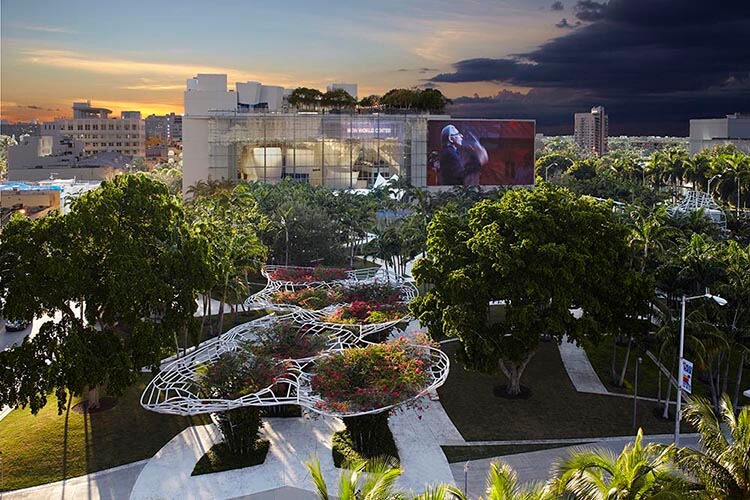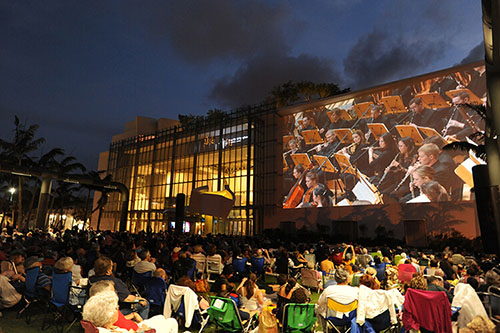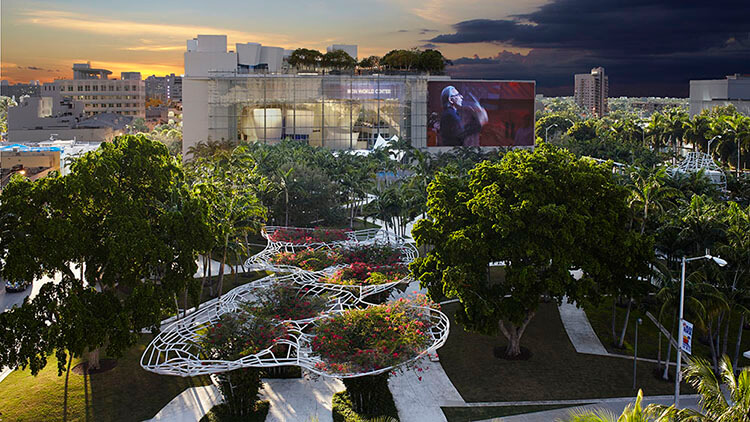When New World Symphony launched season five of its outdoor WALLCAST concert series in October, audiences were greeted with the familiar experience of witnessing world-class musicians perform with the orchestral academy’s students, internally known as “fellows,” in the open air environment of SoundScape Park in Miami.
Immediately adjacent to the performance venue, SoundScape Park offers spectators—typically 2,000-3,000 per event—an intimate setting to view the WALLCAST, which delivers a 100x65-foot live projection of each performance on the 7,000-square-foot eastern façade of the New World Center. The immersive experience is further amplified through the strategic positioning of more than 160 existing Meyer Sound loudspeakers, ensuring audiences are fully engaged with dynamic sound and video.

Immediately adjacent to the performance venue, SoundScape Park offers spectators—typically 2,000-3,000 per event—an intimate setting to view the WALLCAST, which delivers a 100x65-foot live projection of each performance on the 7,000-square-foot eastern façade of the New World Center.
In advance of what is expected to be its busiest season yet, New World Symphony underwent phase one of a multi-stage upgrade that will eventually result in an end-to-end 4K video architecture and a new production control room inside the performance hall. The initial phase mainly focused on the acquisition and projection elements while phase two will center on the remaining video infrastructure, including switching and routing.
Phase-one work was mainly centralized inside the New World Center performance hall, where the WALLCAST concert experiences originate. Enlighten Digital of Orlando served as the prime contractor, focusing on systems design, equipment evaluation, testing, and commissioning. Blackwater Integration of Lakeland, FL, provided all integration services, including wiring, cabling, and equipment installation.
“The main goal of this phase was to increase the resolution and create the best possible picture for the WALLCAST experience,” said Robert Ross, president, Enlighten Digital. “They quickly made the decision that 4K was the proper resolution to serve the audience.”
In cooperation with the New World Center team, Ross worked on a conceptual design to support camera system and projector upgrades. The latter came first, selecting three Christie 4K35 projectors that deliver overlapping projections to blanket the eastern façade. Inside, a system featuring Christie Roadie 30K projectors with a Coolux Pandoras box server supports immersive staging projection.

When New World Symphony launched season five of its outdoor WALLCAST concert series in October, audiences were greeted with the familiar experience of witnessing world-class musicians perform with the orchestral academy’s students, internally known as “fellows,” in the open air environment of SoundScape Park in Miami.The bulk of the integration work centered on the 12 camera positions and the central infrastructure. Hitachi SK-UHD4000 cameras replaced the previous cameras, and they are robotically controlled from the second floor control room via a new Telemetrics system. The Telemetrics system includes a PT-LP-S5 pan/tilt head bundle and an RCCP-1 robotic camera control panel to manipulate all camera movements.
“We immediately knew that the 4K systems would be larger and heavier than their existing cameras and pan/tilt components,” Ross said. “We expected this would be our largest integration challenge up front, but there were other elements we needed to be ahead of—notably preparation for a 4K infrastructure upgrade and relocation of the control room in the third and final phase.”
Building Bridges
Mike Martin, president of Blackwater Integration, was quick to note the delicate nature of managing systems integration in what he calls “a white-glove facility.”
“The concept of the project was establishing that path toward a full 4K architecture, but we had to retain the existing characteristics of the facility,” Martin said. “We had intensive work to do around pulling cable, testing fiber, and reinforcing walls while being extra careful to not take away from the building acoustics. That’s not an easy proposition.”
This is something of an understatement, considering that the 4K systems added three times the existing weight.
“We carefully opened up a pair of walls and installed a backing plate comprised of steel and wood,” Martin said. “That reinforced the camera positions on each side of the theater. We worked closely with the internal New World Center team and their architectural firm to ensure that mounts were appropriately positioned and all wall fillings were replaced. The remaining camera positions came through the ceiling, which required reinforcing the existing 1.5-inch support poles. We also added side bracing to avoid twisting the pipes. Literally anywhere we worked with a camera, we were intently focused on not marking or chipping walls, and maintaining a clean, white-glove workspace.”
Martin and his team then configured the Hitachi cameras and Telemetrics control platform to talk to each other over a local area network. The acquisition signals feed back to the control room over IP, where they are converted to optical signals and sent into the infrastructure. The Blackwater team established a series of quad-link connections to pass 4K signals through the infrastructure, though the goal is to simplify this configuration and provide a pure 4K experience as equipment designs evolve.
The cameras use SMPTE fiber coming out; signals are passed over dual single-mode, and re-assembled for SMPTE fiber going into the CCU. The CCUs are wired for both quad-link 4K and 1080i out, and pass through an AJA Kumo router and onto AJA KiPro recorders. The Christie projectors have both quad-link and 1080i HD connections that they can switch between, depending on the content.
“The infrastructure is set up so that we can quickly go in and transition to a more single-wire or IP-based 4K signal flow depending on how the technology evolves,” Martin said. “The wiring and positioning of the equipment in the second floor control room will also simplify the process of rebuilding the control room from scratch, immediately one floor above the existing space.”
The benefits of choosing Christie, Hitachi, and Telemetrics to support the acquisition and projection upgrade were clear from the testing stage. New World Symphony CEO Howard Herring and director of video production Clyde Scott were both heavily involved in the decision-making process as well, knowing that they not only needed exceptional video quality, but technology that could adapt to the nuances of capturing orchestral performances inside.
“The Hitachi SK-UHD4000 is a whisper-quiet camera that performs well in low-light environments, which is extremely important when shooting dramatic performances in a dark concert hall,” Ross said. “The cameras look impressively pristine, with no noise in the blacks upon testing a recorded 4K signal magnified to 400 percent in a dimly lit room. Telemetrics also came out with this new system right on time that is extremely quiet, emitting almost no sound from the pan/tilt heads. And the Christie projectors simply deliver a beautiful image for the audience with the 4K/HD switching support New World Symphony requires for the foreseeable future.”
